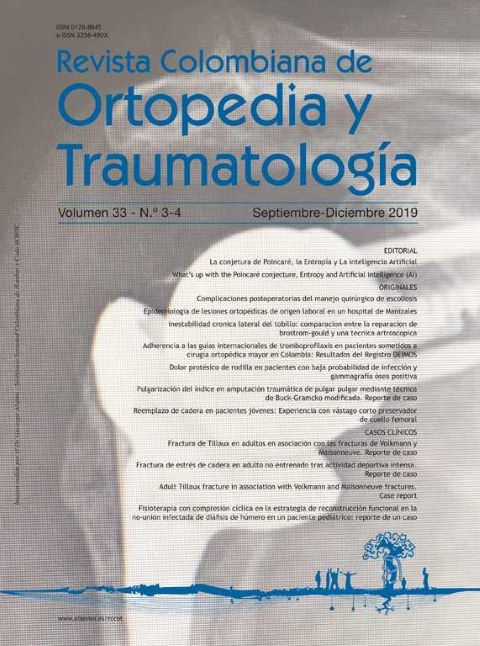Post-operative complications after surgical management of scoliosis
DOI:
https://doi.org/10.1016/j.rccot.2020.02.006Keywords:
scoliosis, spine surgery, complicationsAbstract
Background: The rate of complications in scoliosis surgery remains high. This study intends to determine the characteristics of the patients that are related to the presentation of perioperative complications, and to be able to use this information to take preventive measures.
Material and Method: Descriptive cross-sectional retrospective study, including 230 patients and 318 procedures, was conducted on patients with scoliosis who underwent surgery to correct their deformity. Socio-demographic variables were evaluated using measures of central tendency measurements, followed by a bivariate analysis, and finally a multinomial logistic regression analysis.
Results: A significance of P<.005 was found for diagnosis: neuromuscular and syndromic scoliosis presented with 28.8 and 16.66% of pneumonias, and a prevalence of 15.87 and 33.33% for pleural effusion, respectively. A urinary tract infection (1.88%) was observed in Congenital Scoliosis. A logistic regression model was performed, observing age as the main predictor for presenting with complications, and being more frequent in younger patients (P<.000).
Discussion: It was found that more complications were present in younger patients. This outcome has not been previously reported, but can be used to support conservative behaviour in patients with early-onset scoliosis. The most common complication was pulmonary, with neuromuscular scoliosis being the diagnosis with more complications reported. These data are comparable with those in the literature, and should be taken into account when taking preventive measures and for the development of improvement plans.
Evidence Level: IV
Downloads
References
Nnadi C, Fairbank J. Scoliosis: a review. J Paediatr Child. 2010;20:215-20. https://doi.org/10.1016/j.paed.2009.11.009
Reames DL, Smith JS, Fu K-MG, Polly DW, Ames CP, Berven SH, et al. Complications in the Surgical Treatment of 19,360 Cases of Pediatric Scoliosis. Spine. 2011;36:1484-91. https://doi.org/10.1097/BRS.0b013e3181f3a326
Goldberg CJ, Moore DP, Fogarty EE, Dowling FE. Scoliosis: A Review. Pediatr Surg Int. 2007;24:129-44. https://doi.org/10.1007/s00383-007-2016-5
Mohamad F, Parent S, Pawelek J, Marks M, Bastrom T, Faro F, et al. Perioperative Complications After Surgical Correction in Neuromuscular Scoliosis. J Pediatr Orthop. 2007;27:392-7. https://doi.org/10.1097/01.bpb.0000271321.10869.98
González JL, Soleto FJ, López S, Navascués Del Río JA, Cervera P. Resultados de la instrumentación Galveston-Luque en la escoliosis neuromuscular. Rev Ortop Traumatol. 2002;3: 227-33.
Pérez-Caballero C, Burgos J, Martos I, Pérez A, Vázquez JL, Álvarez E, et al. Complicaciones médicas precoces? en el postoperatorio de cirugía de escoliosis. An Pediatr (Barc). 2006;64:248-51. https://doi.org/10.1157/13085512
Weiss H-R, Goodall D. Rate of complications in scoliosis surgery - a systematic review of the Pub Med literature. Scoliosis. 2008:3. https://doi.org/10.1186/1748-7161-3-9
Martin CT, Pugely AJ, Gao Y, Weinstein SL. Causes and Risk Factors for 30-Day Unplanned Readmissions After Pediatric Spinal Deformity Surgery. Spine. 2015;40:238-46. https://doi.org/10.1097/BRS.0000000000000730
Hresko MT. Idiopathic Scoliosis in Adolescents. N Engl J Med. 2013;368:834-41. https://doi.org/10.1056/NEJMcp1209063
Yadla S, Malone J, Campbell PG, Maltenfort MG, Harrop JS, Sharan AD. Early complications in spine surgery and relation to preoperative diagnosis: a single-center prospective study. J Neurosurg Spine. 2010;13:360-6. https://doi.org/10.3171/2010.3.SPINE09806
Hod-Feins R, Abu-Kishk I, Eshel G, Barr Y, Anekstein Y, Mirovsky Y. Risk Factors Affecting the Immediate Postoperative Course in Pediatric Scoliosis Surgery. Spine. 2007;32:2355-60. https://doi.org/10.1097/BRS.0b013e3181558393
Wang Y, Xie J, Zhao Z, Zhang Y, Li T, Bi N, et al. Perioperative Major Non-neurological Complications in 105 Patients Undergoing Posterior Vertebral Column Resection Procedures for Severe Rigid Deformities. Spine. 2015;40:1289-96. https://doi.org/10.1097/BRS.0000000000000995
Smith JS, Sansur CA, Donaldson WF, Perra JH, Mudiyam R, Choma TJ, et al. Short-term Morbidity and Mortality Associated With Correction of Thoracolumbar Fixed Sagittal Plane Deformity. Spine. 2011;36:958-64. https://doi.org/10.1097/BRS.0b013e3181eabb26
Floccari LV, Milbrandt TA. Surgical Site Infections After Pediatric Spine Surgery. Orthop Clin N Am. 2016;47:387-94. https://doi.org/10.1016/j.ocl.2015.09.001
Martin CT, Pugely AJ, Gao Y, Ilgenfritz RM, Weinstein SL. Incidence and Risk Factors for Early Wound Complications After Spinal Arthrodesis in Children. Spine. 2014;39: 1463-70. https://doi.org/10.1097/BRS.0000000000000446
Segal JB, Guallar E, Powe NR. Autologous blood transfusion in the United States: clinical and nonclinical determinants of use. Transfusion. 2001;41:1539-47. https://doi.org/10.1046/j.1537-2995.2001.41121539.x
Yoshihara H, Yoneoka D. Trends in the Utilization of Blood Transfusions in Spinal Fusion in the United States From 2000 to 2009. Spine. 2014;39:297-303. https://doi.org/10.1097/BRS.0000000000000122
Kannan S, Meert KL, Mooney JF, Hillman-Wiseman C, Warrier I. Bleeding and coagulation changes during spinal fusion surgery: a comparison of neuromuscular and idiopathic scoliosis patients. Pediatr Crit Care Med. 2002;3:364-9. https://doi.org/10.1097/00130478-200210000-00007
Minhas SV, Chow I, Bosco J, Otsuka NY. Assessing the Rates Predictors, and Complications of Blood Transfusion Volume in Posterior Arthrodesis for Adolescent Idiopathic Scoliosis. Spine. 2015;40:1422-30. https://doi.org/10.1097/BRS.0000000000001019
Janssen SJ, Braun Y, Wood KB, Cha TD, Schwab JH. Allogeneic blood transfusions and postoperative infections after lumbar spine surgery. Spine J. 2015;15:901-9. https://doi.org/10.1016/j.spinee.2015.02.010
Elwatidy S, Jamjoom Z, Elgamal E, Zakaria A, Turkistani A, ElDawlatly A. Efficacy and Safety of Prophylactic Large Dose of Tranexamic Acid in Spine Surgery. Spine. 2008;33:2577-80. https://doi.org/10.1097/BRS.0b013e318188b9c5
Lee MJ, Konodi MA, Cizik AM, Bransford RJ, Bellabarba C, Chapman JR. Risk factors for medical complication after spine surgery: a multivariate analysis of 1,591 patients. Spine J. 2012;12:197-206. https://doi.org/10.1016/j.spinee.2011.11.008
Meng F, Cao J, Meng X. Risk factors for surgical site infection following pediatric spinal deformity surgery: a systematic review and meta-analysis. Childs Nerv Syst. 2015;31:521-7. https://doi.org/10.1007/s00381-015-2659-9
Subramanyam R, Schaffzin J, Cudilo EM, Rao MB, Varughese AM. Systematic review of risk factors for surgical site infection in pediatric scoliosis surgery. Spine J. 2015;15:1422-31. https://doi.org/10.1016/j.spinee.2015.03.005
Nachemson AL, Peterson LE. Effectiveness of treatment with a brace in girls who have adolescent idiopathic scoliosis. A prospective, controlled study based on data from the Brace Study of the Scoliosis Research Society. J Bone Joint Surg. 1995;77:815-22. https://doi.org/10.2106/00004623-199506000-00001
Demirkiran HG, Bekmez S, Celilov R, Ayvaz M, Dede O, Yazici M. Serial Derotational Casting in Congenital Scoliosis as a Timebuying Strategy. J Pediatr Orthop. 2015;35:43-9. https://doi.org/10.1097/BPO.0000000000000229





